For today’s dehydrator project, we have an exciting task at hand, we are going to dehydrate hash browns. Actually, we are dehydrating frozen hash browns. The beauty of this endeavor lies in the fact that the work of shredding and preparing the potatoes has already been taken care of for us.
Now, you might be wondering why we wouldn’t just purchase a large bag of fresh Idaho’s, peel and shred them, blanch them, and so on. The answer lies in the value of time. When doing these dehydrator projects, using frozen and prepared ingredients can be a smart choice. It allows us to save precious time without compromising the quality of the end result.

In this guide, we’ll review the tools and the process involved in dehydrating frozen hash browns. We’ll also share some excerpts from my own Dehydrator logbook, where I take notes describing what I am dehydrating, the setup, duration, and before and after weights. This information helps me easily build out my homemade camping meals.
Lastly, we’ll wrap it up with a few insider tips and tricks worth mentioning. The primary focus of the Dehydrator Chef website is to create decent-quality, good-tasting foods that quickly and easily rehydrate using ordinary camping and backpacking kitchen gear. These ingredients and meal ideas also work for those wanting to stock up their pantry, either to reduce food waste or to prepare for unexpected events.
So grab your dehydrator and let’s get started dehydrating frozen hash browns.
How to Dehydrate Frozen Hash Browns
A big benefit of dehydrating already processed food is that the hard work of slicing, dicing, and shredding has already been done for you. There is no shame in wanting to save some time.
One of the advantages of working with frozen hash browns is that there’s no real need to defrost them beforehand. However, it might be wise to allow them to thaw slightly so that any larger clumps can more easily be broken apart. As a bonus, the bagged frozen shredded potatoes we buy in the store have already undergone pretreatment to prevent the browning of the cut potatoes.

Pretreatment methods for fruits and soft vegetables prevent oxidation and break down cell walls if needed. Typically, pretreatment involves soaking the product in a solution of lemon or lime juice (citric acid) or vitamin C (ascorbic acid) mixed with water. This acts as an antioxidant, preventing significant color changes during dehydration.
For this project, we’ll be using plain ole’ frozen shredded hash browns. We are leaving those frozen fries, potatoes O’Brien, sweet potatoes, potato blends, and other options behind. So stock up and toss a couple of bags in the shopping cart on your next trip.
Prepping frozen hash brown potatoes for dehydration is super simple. Just buy the bag and get it home. Simple as that.
Supplies Needed for Dehydrating Frozen Hash Brown Potatoes
To dehydrate frozen hash browns, you’ll need the following supplies:
- A good quality food dehydrator. We recommend the Nesco FD-75A, which we believe is the best food dehydrator for long-term food storage needs. You can check out our food dehydrator guide for more information.
- A couple of bags of shredded and frozen hash brown potatoes.
- Food dehydrator with removable mesh screen inserts or removable fruit roll sheets for the dehydrator trays.
- Wide-mouth canning funnel.
- Canning jars.
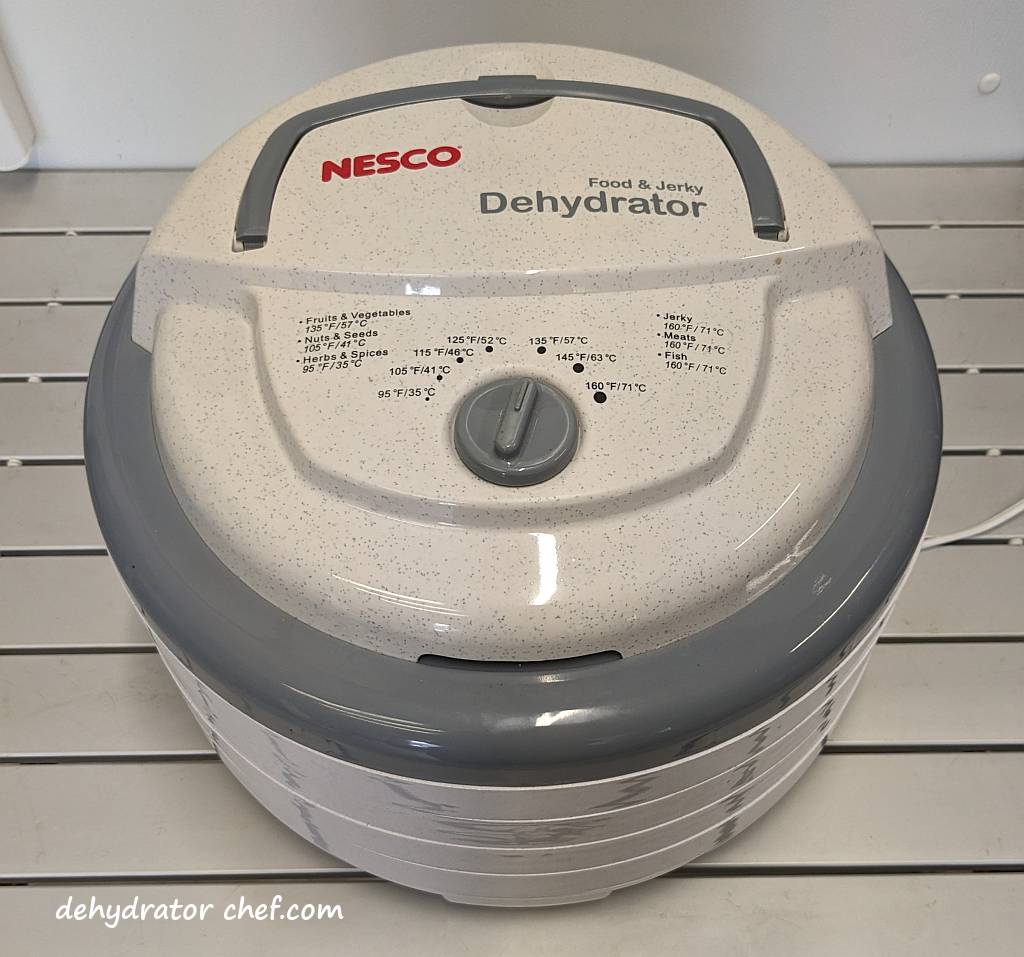
For planning purposes, a 30-ounce bag of frozen hash browns will fill up 2 or 3 round Nesco FD-75A dehydrator trays. Since we mostly dehydrate individual ingredients for our meals, we’ll dehydrate several bags at once to replenish our pantry and make the most of our time.
You’ll also need removable mesh screen inserts; one will be needed for each of the dehydrator trays.
Step 1. Process the Frozen Hash Browns for Dehydrating
There isn’t much to do in terms of preparing the frozen hash browns for dehydration. However, the Ore-Ida brand product label indicates that they should be cooked thoroughly.
Our Dehydrator Chef recipes mainly involve reheating and hydrating cooked ingredients. So we will want to mostly cook the shredded potatoes, but not fully cook them to tenderness.
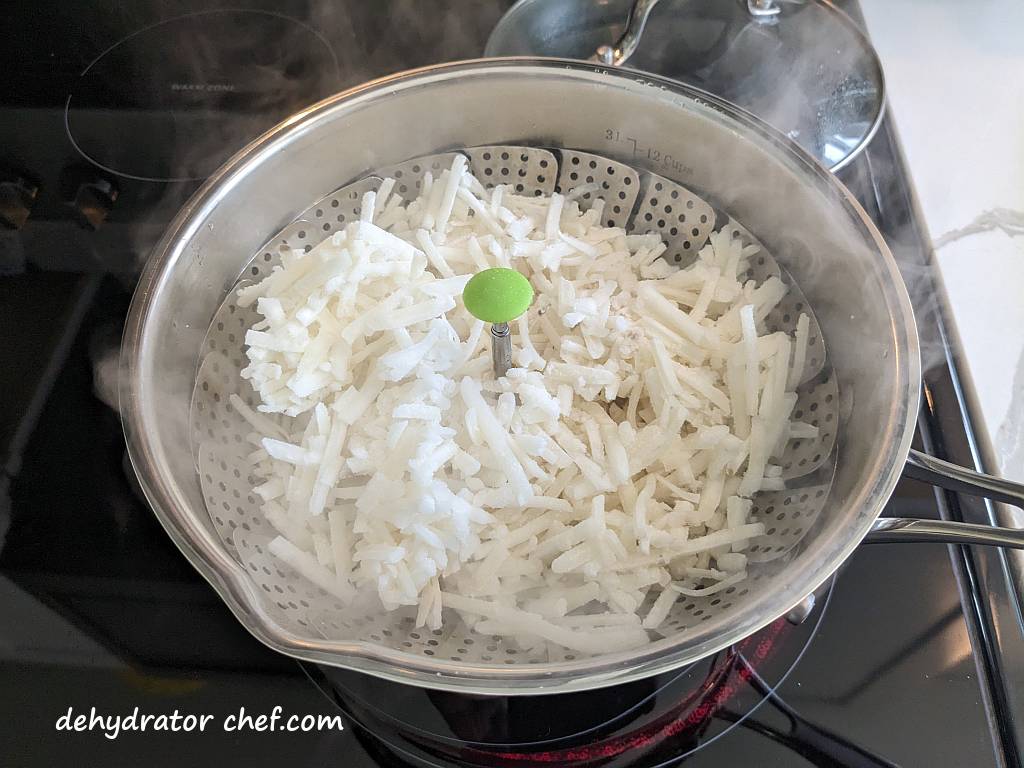
To achieve this, we will steam-cook the frozen hash browns for a few minutes, just enough to thaw, soften, and slightly cook the potato shreds. We’ll use a steamer basket and steam them in batches for approximately 2 minutes. After steaming, we’ll cool them in an ice bath to stop the cooking process and then drain any excess water in a colander. Do a taste test after a minute or so of steaming to gauge tenderness. We want some tenderness and also some bite left.
To begin, open the bag and place a couple of handfuls of the frozen hash browns in the steamer basket, breaking apart any large clumps. After around 1 or 2 minutes when the hash browns pass the tenderness test, remove the steamer basket and submerge it in the ice bath to halt the cooking. Avoid steaming them for too long, as they may become fully cooked and turn mushy.
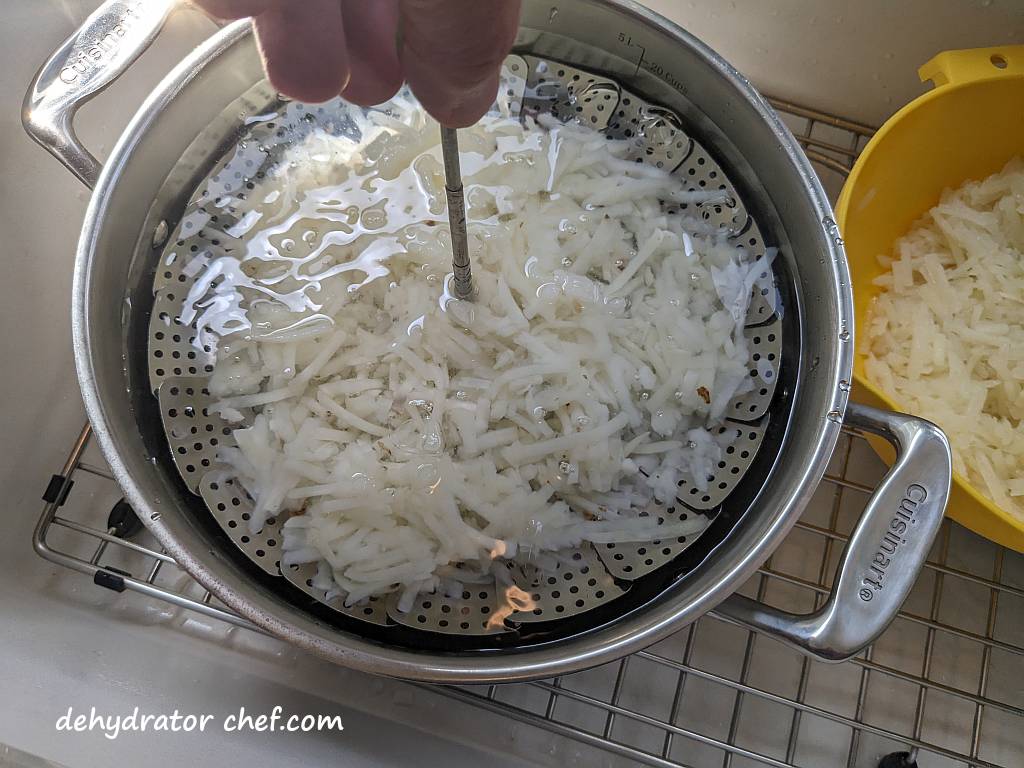
Once they have been in the ice bath, transfer the contents of the steamer basket into a colander to allow any excess water to drain.
Step 2. Preparing the Dehydrator for Dehydrating Frozen Hash Browns
One 30-ounce bag of frozen hash browns will fill 2 or 3 of my round Nesco FD-75A dehydrator trays with the removable mesh screen inserts.
To ensure even drying, spread the drained hash browns in a thin and consistent layer on the removable mesh screen inserts or the removable fruit roll sheets. Using either will work fine. It’s important to avoid creating any clumps of hash browns, as this can lead to case hardening and uneven drying.

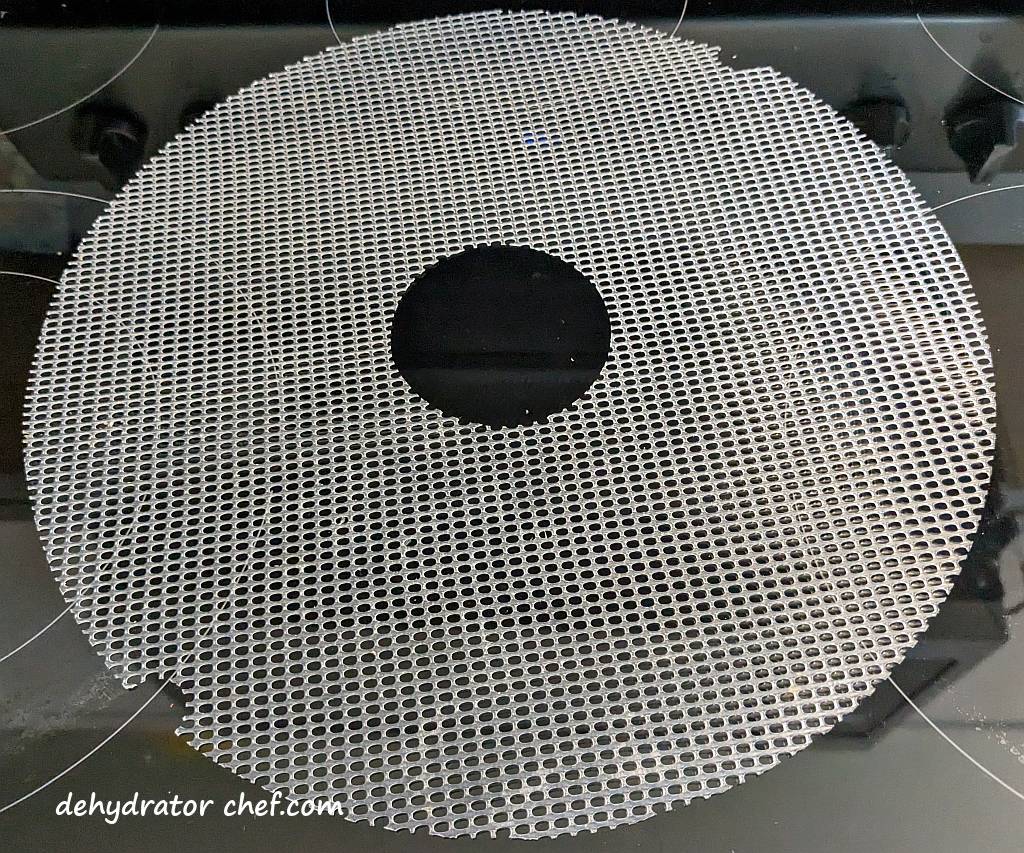

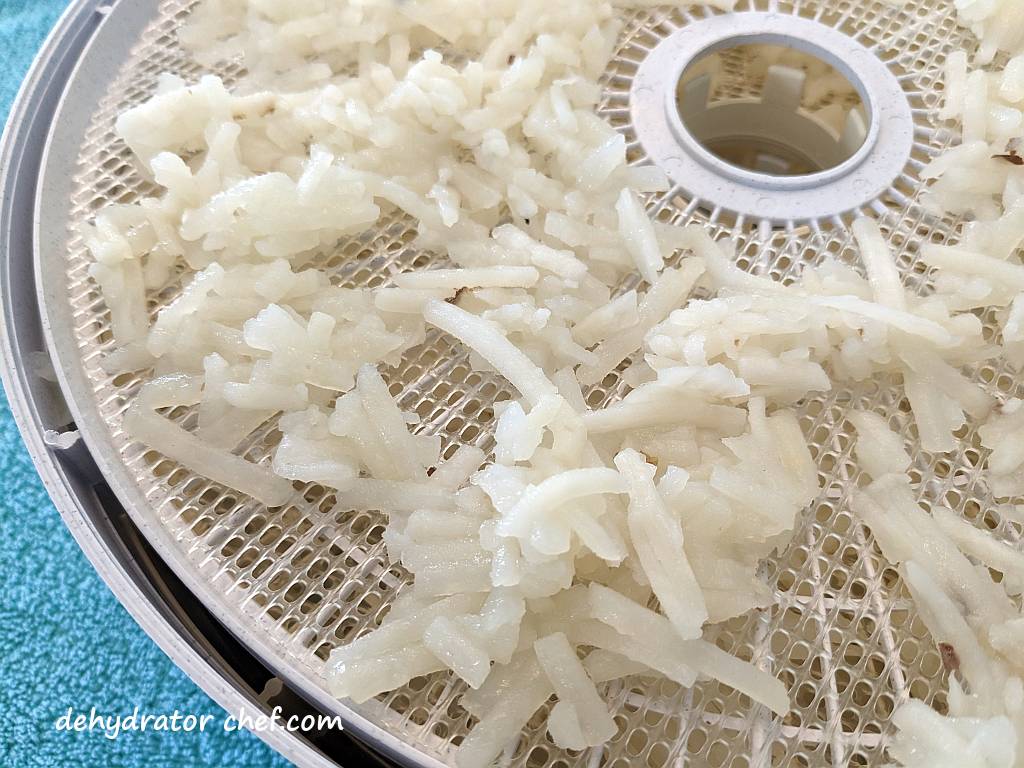
The Nesco FD-75A food dehydrator tray has close to 119 square inches or .8 square feet of surface area for drying.
Step 3. Dehydrating the Frozen Hash Brown Potatoes
Begin by setting the dehydrator temperature to 135°F / 57°C. Based on my experience, a drying time of 18 to 24 hours works well for dehydrating hash browns.
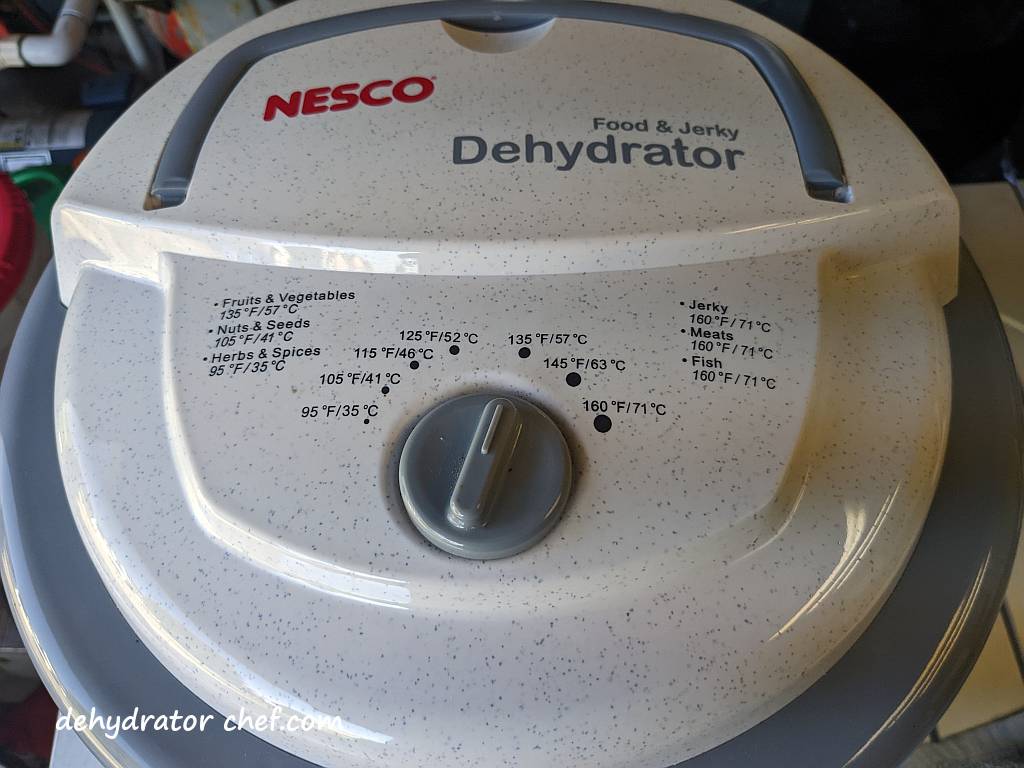
Remember to use drying times only as a guide. Of course, drying times are variable and dependent on the ambient temperature and humidity, how many trays, and how crowded or thickly you layer food into your dehydrator trays.
The outer layer of a big hash brown potato clump may dry quickly and prevent the inside moisture from escaping, otherwise known as case hardening.
Case hardening is a phenomenon that can occur during the drying process of certain foods. It refers to the development of a hard outer crust or surface layer on the food, which can prevent the escape of moisture from the interior. This can lead to uneven drying and potentially result in moisture retention.
To prevent case hardening, it’s recommended to break apart any clumps into smaller pieces approximately 45 minutes to an hour after starting the dehydrator. This will help ensure that the moisture inside the hash browns can escape evenly during the dehydration process.
Step 4. When are the Dehydrated Hash Brown Potatoes Done
After 18 to 24 hours, the hash browns should be fully dehydrated. If not, let it go another 2 or 4 hours and check again.
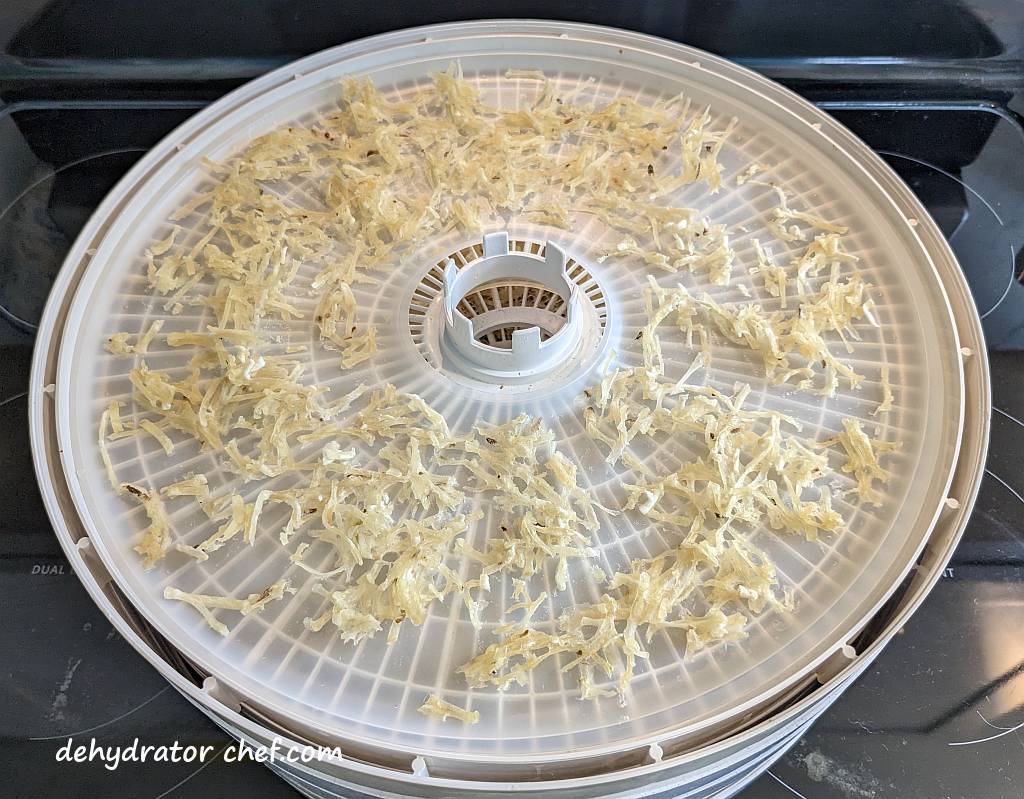
The dehydrated hash browns are done when it easily crumbles. Warm hash browns still in the food dehydrator may feel somewhat bendy, and you may believe it needs more drying time. Simply unplug the dehydrator and let everything cool down. Then check again to be sure. The dried potato pieces are brittle and should easily crush and crumble into smaller pieces.
Drying times will vary depending on your dehydrator. Refer to your dehydrator owner’s manual for recommended temperatures and times for dehydrating specific foods. Remember to use drying times as a guide.
Any clumps should have already been broken down into smaller pieces. If any remain, break them apart, detecting for case hardening. Continue dehydrating until it’s all done.
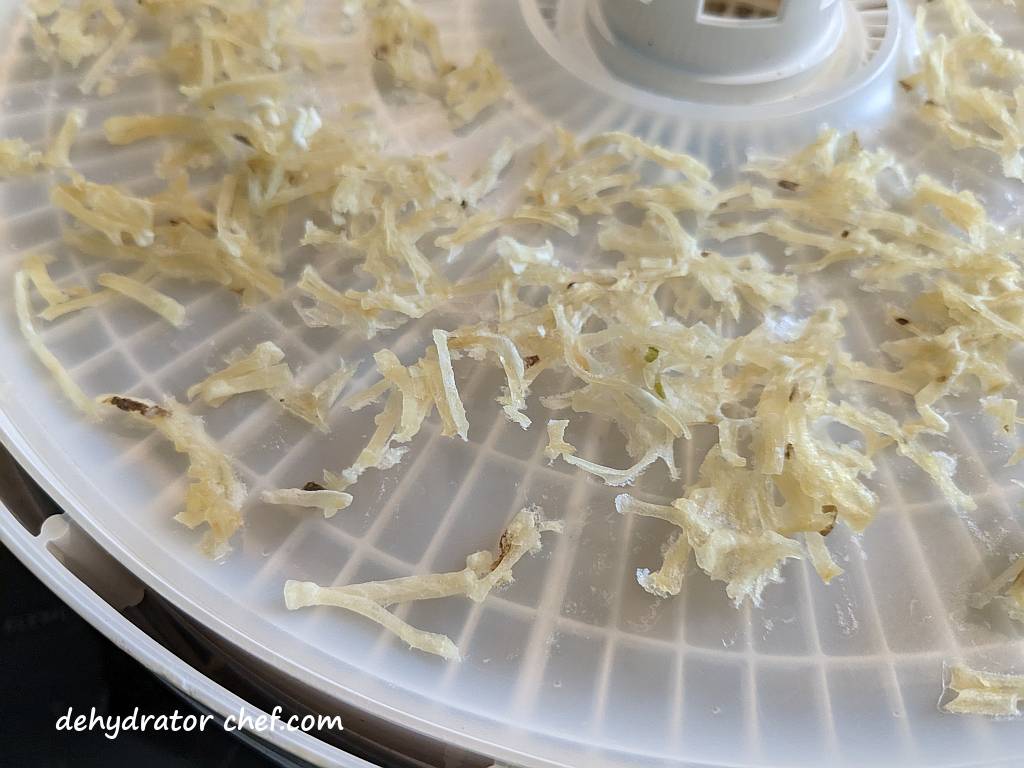
With experience, you will develop a sense for identifying case hardening. In the meantime, it’s recommended to thoroughly check for dryness before considering the hash browns completely done.
Step 5. Equalizing and Conditioning of the Dehydrated Hash Browns
We always recommend letting food items cool completely after they have finished dehydrating and before packing them into an airtight storage container for equalizing and conditioning. Warm food may cause sweating which could provide enough moisture for mold to grow.
It does not take long for dehydrated food items to start hydrating from ambient household humidity. Do not leave dehydrated food items exposed to the elements any longer than necessary because of the increased risk of mold growth.
The partially cooked and dehydrated hash browns may have a tendency to stick together and form a web-like sheet. This is normal, and you can simply break the sheet into manageable pieces that will fit inside your canning jars.
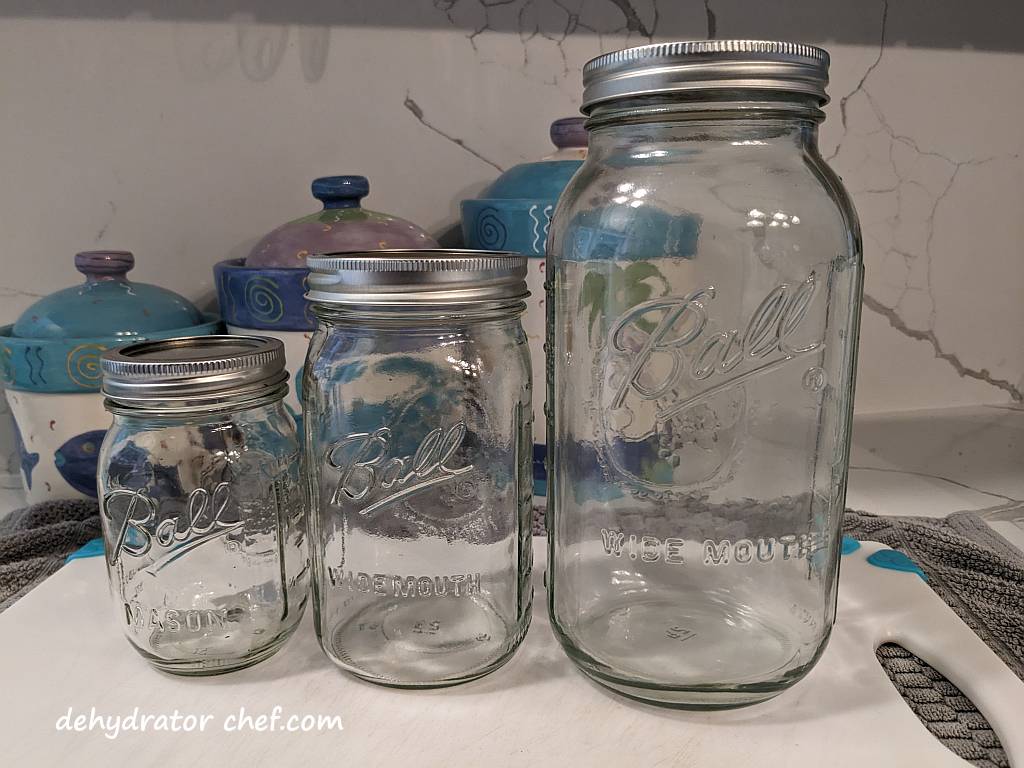
After a brief cooling period, loosely pack the dehydrated hash brown pieces into a clean, dry, insect-proof, and air-tight storage container.
Avoid crushing or mashing the dehydrated food if it doesn’t fit into a single jar. Instead, opt for a larger jar or use additional jars. If you frequently dehydrate food in large quantities, consider investing in larger canning jars to prevent over-packing and crushing food items. Ample space inside the jar allows for mixing, rolling, and thorough examination of the contents for any potential mold formation during the conditioning process. Since the canning jars are clear, it’s easy to see what’s inside.
A quality stainless steel or plastic canning funnel makes the messy job of getting dehydrated foods off the dehydrator tray removable inserts and into the canning jars an easy task. Take a minute or two and check them out here on Amazon.
When the dehydrated food pieces are removed from the dehydrator, the remaining moisture may not be distributed equally among the pieces because of their location and position in the dehydrator. Equalizing and conditioning is a process for freshly dehydrated foods that ensures any residual moisture remaining in any piece is spread, or equalized, among all the other pieces in the batch. Let the dried hash browns equalize and condition in the storage container for 7 to 10 days.
Every day check the jar for moisture and roll the contents of the jar around and note any clumping or sticking. If seen, put the contents back on the dehydrator for several more hours.
If you notice any mold, even the smallest bit, throw it all out. What you see are the mold spores finally blooming enough to make them visible. But there are more, even tinier mold spores in the rest of your jar that make your dehydrated food inedible. Toss it out and start another batch.
Step 6. Storing Dehydrated Hash Browns
Use an appropriately sized canning jar for storage. The dehydrated hash browns might keep up to 12 months or longer. Exactly how long depends on how well you dehydrate and condition the hash browns and your pantry storage conditions.
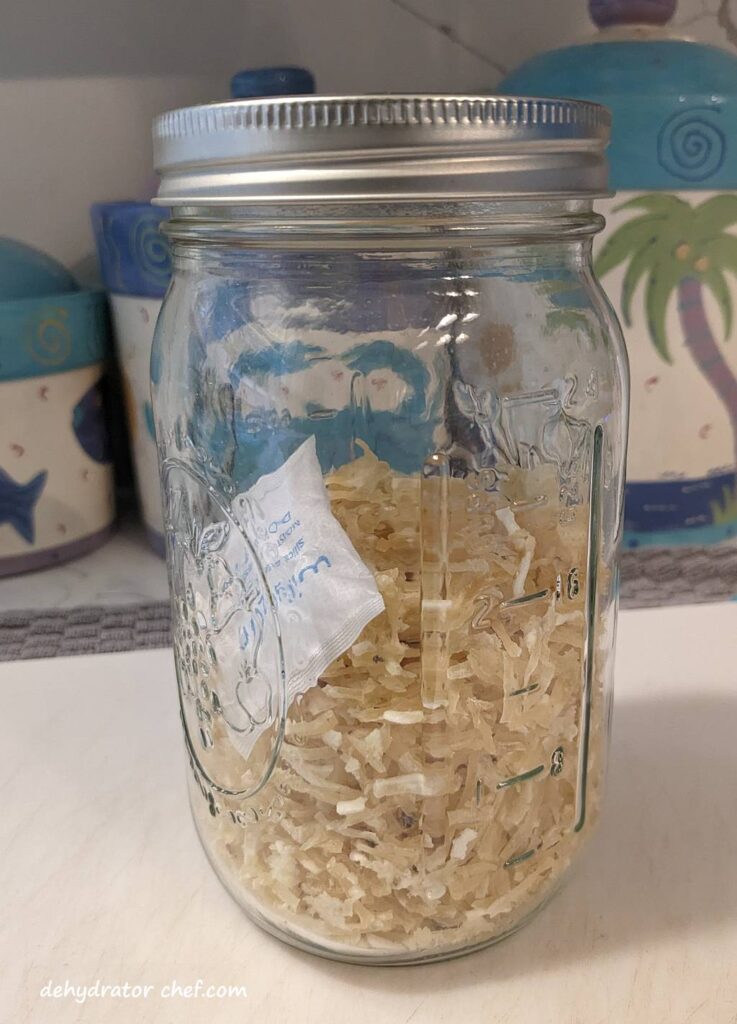
We’ll use a food-safe desiccant packet for moisture control because we live in a fairly humid area. For our pint-size or quart-size mason jars, we’ll use a single food safe 5 -gram desiccant packet. For larger jars, we’ll add 2 packets. The desiccant packets will absorb any moisture and help extend the shelf life of the dehydrated food.

We use these inexpensive food-safe desiccant packets which are available from Amazon. These 5-gram packets have over 5000 of mostly 4- and 5-star customer reviews, with an average of 4.7 stars out of 5. Our bag of 60 desiccant packets will last quite a while because they can be recharged and reused multiple times. Other food-safe sizes are available.
Lastly, I’ll attach or include a short note describing the jar contents and the date the product was dehydrated. The note also lets me know where to go in my dehydrator logbook if I want to make another note or two.
Hydration
Hydrate the dried hash browns using roughly a 1-to-1 ratio of dehydrated product to boiled water. Plan on at least 15 to 20 minutes to fully hydrate.
If you’re supplementing store-bought freeze-dried meals as we often do, just add a bit more boiling water to the food pouch. Use the same 1-to-1 ratio of dehydrated hash browns to water and account for the extra time. I find that most store-bought freeze-dried meals could use a little extra to bump up the calorie count, contents, or add more nutrition.
Weights, Measures, and Serving Sizes
This information is from a recent logbook entry on the notes we keep on most of our food dehydration efforts.
We picked up two 30-ounce bags (850 grams) of frozen hash browns at the local grocer. Cost each: $3.68 without taxes.
One 30-ounce bag filled up 2 dehydrator trays and half of another tray with the removable mesh screen inserts. There were a few clumps of hash browns, but we broke those into pieces.
Trays on the dehydrator at 1150, 135 °F.
At 1415, broke apart the bigger potato clump into smaller pieces to prevent them from case hardening.
Checked at 1800, and they are not done
Turned off and removed from the dehydrator the next morning at 0830. Let cool for about 15 or 20 minutes.
The total dehydrated weight for both packages of hash browns was 310 grams. So each package dehydrated into approximately 155 grams.
The Nutrition Facts showed there were approximately 10 servings per container, and a single serving size was 1 1/4 cups (85 grams).
Doing the math, 155 grams / 10 1 1/4 cup servings = 15 grams.
Insider Tips
Besides dehydrated meal recipes found here on this website, add dehydrated hash browns to any of your favorite freeze-dried food pouches for a bit more nutrition.
Just be sure to compensate by adding additional boiled water in roughly a 1-to-1 ratio of added dehydrated hash browns to boiling water to the freeze-dried meal and allow enough time for adequate hydration.
Conclusion
Dehydrating hash browns is an excellent way to prepare for your camping or emergency food needs. With this comprehensive guide, you can easily dehydrate foods using the basic tools we have talked about here. Follow these simple steps, and you will have a versatile food source that will last for a long time properly stored in the pantry.
